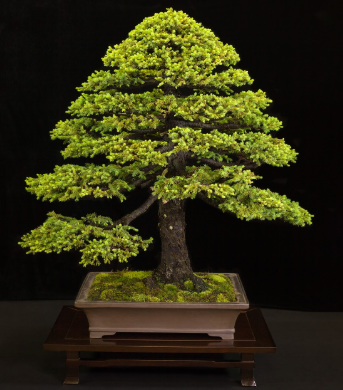Ezo spruce
After a journey that started in Japan and led to the White House, before eventually settling at the Museum, it’s safe to say the Ezo spruce has an amazing history. We spoke with Museum curator Michael James about the small evergreen’s impressive origin story for this month’s historical tree spotlight!
According to James, international bonsai master and philosopher Saburo Kato first presented the tree to the late Japanese Prime Minister Keizō Obuchi in 1998. The prime minister then gifted the spruce to former President Bill Clinton at a formal state dinner in Tokyo that November.
In December 1998, the tree was flown to Washington, D.C. and placed in quarantine at the National Plant Germplasm Quarantine Center, until it was released to the National Arboretum the following year.
The tree was then displayed in the White House’s blue room in 1999, when Saburo Kato personally introduced President Clinton and Prime Minister Obuchi to the sensational art of bonsai. Kato’s well-respected family was the first to establish a nursery in Omiya, Japan – called Mansei-en – which earned a reputation as a global bonsai hub.
Tomekichi Kato II, Saburo’s father, was the first to develop the horticultural techniques necessary to cultivate the Ezo spruce as a bonsai: Saburo Kato’s spruce boasts the Formal Upright style, exhibiting the rare and highly prized Japanese concept of “Shin.”
Kato collected the tree in 1939 from Kunashir, a Japanese island with a subarctic climate. It has been in training ever since.
In its native area, which ranges from mountains in central Japan to the China-North Korea border, the spruce can grow to be a large evergreen towering at more than 100 feet tall. The tree is used to cold climates, so although it mostly grows during the four warmer months of the year, it can survive under a protective blanket of snow in winter.
The Ezo is difficult to import, as the spruce hosts a fungus known for infecting species of rhododendron and azalea, but the Museum houses three of the trees in the Japanese Pavilion.
James said one should spray the spruce’s foliage to reduce its temperature on hot days, and that the tree must always be kept moist because it grows surface roots.
“Its beauty is most spectacular in the spring, when its lime green shoots emerge from winter dormancy and contrast the dark green needles from years past,” he said.
After new shoots emerge and begin to elongate, curators carefully pinch the shoots to keep the tree in balance and maintain its good form, James said.
He added that the Ezo’s fibrous surface roots allow the tree to produce healthy and full “nebari,” or root flare, which add to the tree’s visual balance. The spruce’s fine and delicate needles are compact, which creates the impression of a tree that is over 100 feet tall when it actually stands less than four feet tall.
“Its bark has a very fine flakiness that contributes to a look of age that is in proportion to its small size as a bonsai,” James said.




